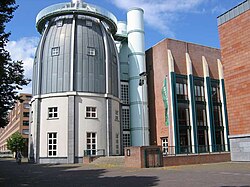Bonnefantenmuseum
 |
|
| Established | 1884 |
|---|---|
| Location | Avenue Céramique 250, Maastricht, Netherlands |
| Coordinates | 50°30′12″N 5°25′15″W / 50.5034°N 5.4209°W |
| Director | Stijn Huijts |
| Website | www.bonnefanten.nl |
The Bonnefanten Museum is a museum of fine art in Maastricht, Netherlands.
The museum was founded in 1884 as the historical and archaeological museum of the Dutch province of Limburg. The name Bonnefanten Museum is derived from the French 'bons enfants' ('good children'), the popular name of a former convent that housed the museum from 1951 until 1978.
In 1995, the museum moved to its present location, a former industrial site named 'Céramique'. The new building was designed by the Italian architect Aldo Rossi. With its rocket-shaped cupola overlooking the river Maas, it is one of Maastricht's most prominent modern buildings.
Since 1999, the museum has become exclusively an art museum. The historical and archaeological collections were housed elsewhere. The museum is largely funded by the province of Limburg.
In 2009, the museum celebrated its 125th anniversary with the exhibition Exile on Main Street. In 2012, Stijn Huijts became director.
The combination of old art and contemporary art under one roof gives the Bonnefanten Museum its distinctive character. The department of old masters is located on the first floor and displays highlights of early Italian, Flemish and Dutch painting. Exhibited on the same floor is the museum's extensive collection of Medieval sculpture. The contemporary art collection is exhibited on the second floor and focuses on American Minimalism, Italian Arte Povera and Concept Art. The second and third floors are also used for temporary exhibitions.
The collection old art of the Bonnefanten Museum consist of four main sections:
Since Alexander van Grevenstein became director in 1986, the Bonnefanten Museum has focused mainly on contemporary art. In 2006, an important long-term loan from the Belgian architect Charles Vandenhove and his wife greatly strengthened the museum's collection of postwar art. The main focus of the permanent collection is now on:
...
Wikipedia
